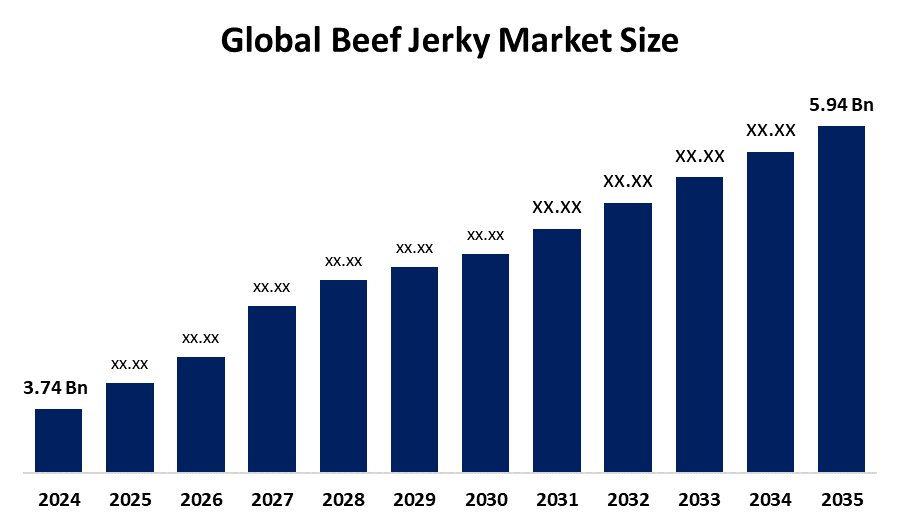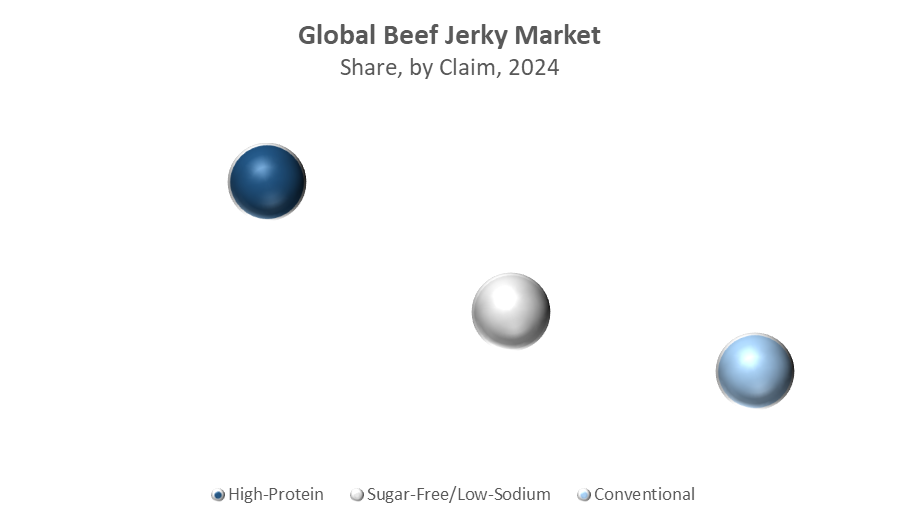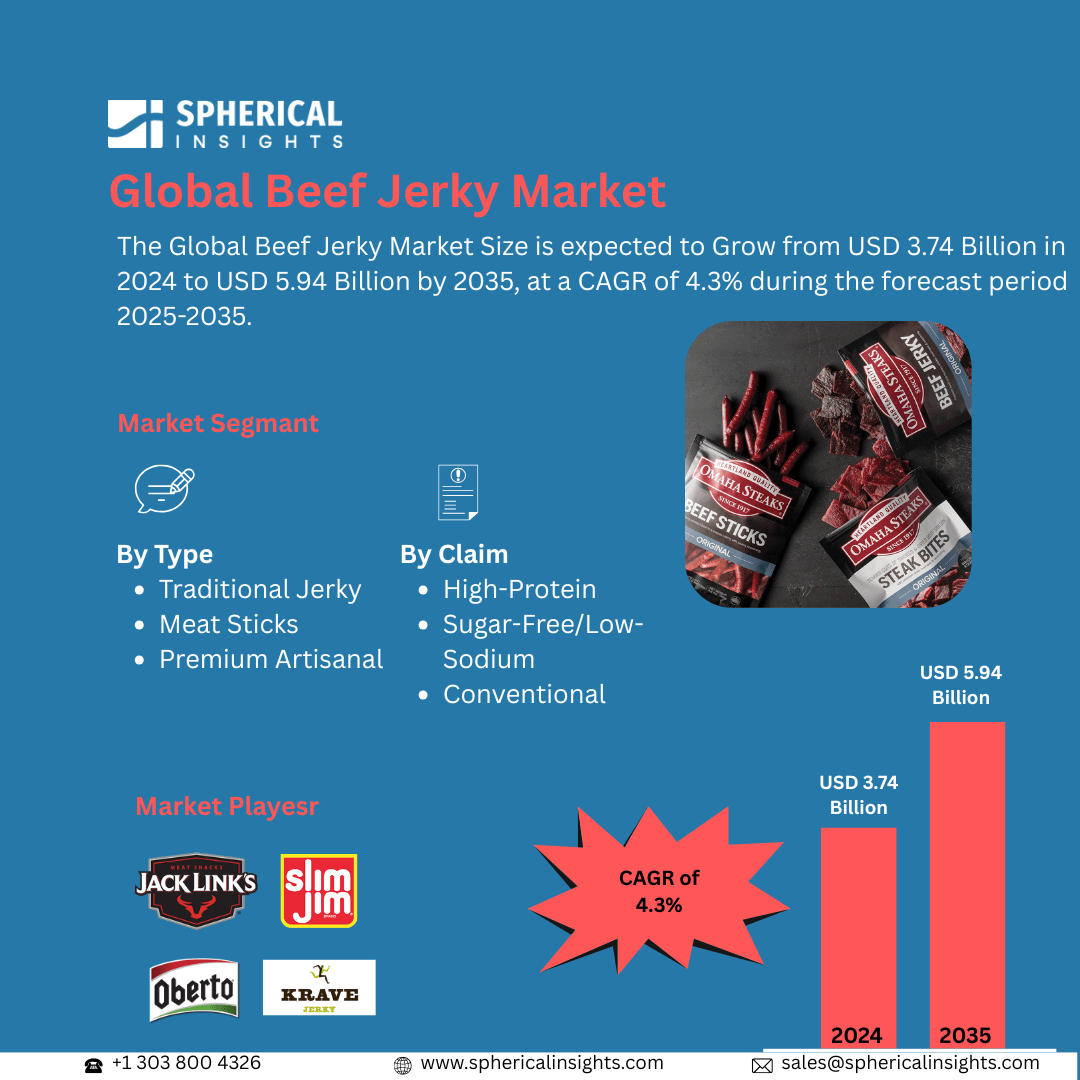Beef Jerky Market Summary, Size & Emerging Trends
According to Decision Advisor, The Global Beef Jerky Market Size is expected to Grow from USD 3.74 Billion in 2024 to USD 5.94 Billion by 2035, at a CAGR of 4.3% during the forecast period 2025-2035. The growing consumer shift toward high-protein, convenient, and low-sugar snacks is driving demand for beef jerky globally. Increasing health awareness, busy lifestyles, and the rising popularity of on-the-go protein snacks are key factors fueling market expansion.
Key Market Insights
- North America is expected to account for the largest share in the beef jerky market during the forecast period.
- By type, the traditional jerky segment dominated the market in 2024, driven by its wide availability and consumer familiarity.
- By claim, the high-protein segment accounted for the largest revenue share due to increasing fitness and wellness trends.
- Asia-Pacific is projected to be the fastest-growing market, driven by expanding retail distribution and rising western dietary influence.
Global Market Forecast and Revenue Outlook
- 2024 Market Size: USD 3.74 Billion
- 2035 Projected Market Size: USD 5.94 Billion
- CAGR (2025-2035): 4.3%
- North America: Largest market in 2024
- Asia Pacific: Fastest growing market

Beef Jerky Market
The beef jerky market revolves around producing and consuming dried, seasoned beef snacks known for their long shelf life, portability, and rich protein content. It is gaining popularity as a convenient, nutritious snack among health-conscious and active consumers. Manufacturers are focusing on innovations such as natural ingredients, exotic flavors, and clean-label formulations to meet evolving preferences. The rise in fitness trends, outdoor activities, and demand for premium snacks further drives market growth. Additionally, increasing emphasis by governments on low-sodium and natural preservation standards supports the shift toward artisanal and high-quality jerky products. The rapid expansion of e-commerce and convenience stores enhances product accessibility and global brand exposure, especially in emerging markets. Overall, the beef jerky market continues to expand as consumers prioritize protein-rich, convenient, and flavorful snacking options worldwide.
Beef Jerky Market Trends
- Rising popularity of high-protein, keto-friendly, and low-sugar snacks among consumers.
- Premium artisanal jerky products featuring grass-fed beef and exotic flavors gaining traction.
- Expansion of direct-to-consumer (D2C) and e-commerce channels.
- Introduction of plant-based and hybrid jerky alternatives broadening product portfolios.
- Increasing focus on sustainable sourcing and traceability in meat production.
Beef Jerky Market Dynamics
Driving Factors: Growing Demand for High-Protein and Convenient Snacks
The surge in global health and fitness awareness is one of the key factors driving the beef jerky market. Consumers are increasingly adopting high-protein, low-carb diets, making beef jerky a popular choice due to its nutrient density and portability. Its long shelf life and suitability for on-the-go consumption make it ideal for athletes, travelers, and working professionals. Additionally, product innovation, including unique flavor profiles (like teriyaki, smoked, and spicy variants), re-sealable packaging, and portion-controlled packs, enhances convenience and consumer engagement. The rapid growth of modern retail, convenience stores, and online delivery platforms further increases accessibility, strengthening global demand.
Restraint Factors: Rising Raw Meat Prices and Clean-Label Compliance Costs
The market faces ongoing challenges from fluctuating beef prices driven by supply-demand imbalances and environmental constraints in livestock production. These cost fluctuations directly impact manufacturers’ profit margins. Moreover, the growing global shift toward clean-label, non-GMO, and organic food standards raises manufacturing and sourcing costs. Meeting stringent food safety and traceability regulations requires significant investment in quality control and certifications. Packaging and logistics costs, especially for international distribution, also add financial pressure. Additionally, the rising availability of plant-based jerky made from soy, mushrooms, or jackfruit presents a competitive restraint by attracting vegan and flexitarian consumers.
Opportunities: Expansion into Premium and Functional Snack Categories
The market presents strong growth potential in premiumization and functional snacking. Consumers are increasingly willing to pay for grass-fed, organic, antibiotic-free, and sustainably sourced beef jerky that aligns with ethical and health-oriented values. Innovative products enriched with probiotics, collagen, or added vitamins are gaining momentum as functional snacks. Growing disposable incomes and the westernisation of diets in Asia-Pacific and Latin America are fueling regional demand. Emerging brands can capitalise on this by introducing localised flavours, eco-friendly packaging, and limited-edition artisanal products, expanding both market share and profitability.
Challenges: Supply Chain Disruptions and Sustainability Pressures
Global supply chain instability triggered by events such as the COVID-19 pandemic, geopolitical conflicts, and logistics bottlenecks continues to affect beef supply and cost predictability. The industry also faces increasing scrutiny over the environmental impact of cattle farming, including methane emissions and land use concerns. Sustainability has become a central challenge, pushing manufacturers to adopt carbon-neutral practices, renewable energy, and ethical sourcing of raw materials. Maintaining consistent quality while ensuring traceability and regulatory compliance across regions adds further complexity. However, companies that effectively integrate sustainability and transparency into their business models are positioned to gain a competitive edge in the evolving market landscape.
Global Beef Jerky Market Ecosystem Analysis
The global beef jerky market ecosystem involves a well-connected network of stakeholders, including raw material suppliers (cattle farmers and meat processors), manufacturers (such as Jack Link’s, Conagra Brands, and KRAVE Jerky), and distributors (retail chains, convenience stores, and e-commerce platforms). End consumers range from fitness enthusiasts to travelers seeking high-protein snacks. The ecosystem is influenced by trends in sustainability, quality assurance, and flavor innovation. Strategic partnerships, technological advancements, and efficient supply chains are crucial in ensuring product consistency, competitive pricing, and global market expansion.
Global Beef Jerky Market, By Type
The traditional jerky segment dominated the global market in 2024, accounting for approximately 58.3% of total revenue. Its strong performance is attributed to its classic flavor profile, affordability, and wide consumer familiarity. Traditional jerky remains a staple choice among long-time consumers seeking authentic, smoky, and savory flavors. Its availability across all major retail and convenience store channels also reinforces its leading position. Manufacturers continue to innovate by introducing reduced-sodium and grass-fed beef variants, appealing to both traditional and health-conscious consumers.
The meat sticks segment represented around 27.6% of the market share in 2024. Growth is driven by the rising preference for portable, portion-controlled, and resealable packaging that suits busy, on-the-go lifestyles. Meat sticks appeal to younger consumers, athletes, and travelers due to their convenience and variety of flavors. Increasing product availability through vending machines, gas stations, and online retail platforms continues to expand this segment’s reach globally.
Global Beef Jerky Market, By Claim
The high-protein segment held the largest market share in 2024, accounting for approximately 54.7% of total revenue. Its dominance is driven by growing demand from health-conscious consumers, athletes, and fitness enthusiasts who prioritize protein-rich snacks for muscle building and energy. High-protein beef jerky appeals as a convenient, nutrient-dense option suitable for on-the-go consumption. Manufacturers are enhancing this segment by offering lean cuts, grass-fed beef, and fortified protein variants, further solidifying its position as the market leader.

The sugar-free/low-sodium segment represented around 22.9% of the market in 2024 and is expected to register the highest CAGR of 6.4%. Rising awareness of dietary restrictions, heart health, and clean-label preferences drives this growth. Consumers increasingly prefer jerky with minimal additives and reduced sodium or sugar, prompting manufacturers to develop healthier formulations. Expansion through health-focused retail channels and e-commerce platforms further supports adoption of sugar-free and low-sodium beef jerky globally.
North America led the global beef jerky market in 2024, contributing approximately 45% of total revenue. This dominance stems from a well-established snacking culture and the presence of major brands like Jack Link’s, Slim Jim, and Oberto, which drive brand loyalty and consistent consumption. The growing health and fitness trend, with consumers seeking high-protein, low-fat snacks, further boosts demand. Strong distribution networks across supermarkets, convenience stores, and online platforms make beef jerky highly accessible. Additionally, innovations in flavors, packaging, and portion sizes cater to busy lifestyles, strengthening market growth.
Europe is experiencing steady growth, due to increasing awareness of high-protein, clean-label, and low-sodium meat snacks. Countries like the UK and Germany lead the market as gym culture and fitness awareness rise. The popularity of online retail and e-commerce platforms enhances product reach. Health-conscious consumers are increasingly choosing beef jerky as a convenient snack that aligns with dietary preferences. Regulatory support for clean-label and natural ingredients also encourages product innovation and adoption.
Asia-Pacific is the fastest-growing region, projected to grow at a CAGR of 7.2%. Growth is fueled by rising disposable income, urbanization, and exposure to Western dietary habits in countries like China, Japan, and South Korea. Expanding modern retail chains, convenience stores, and e-commerce platforms increase accessibility. Consumers are increasingly adopting protein-rich and portable snacks, driven by fitness trends and busy urban lifestyles. The combination of premiumization and functional product offerings, such as organic or low-sodium jerky, further strengthens market potential in this region.
WORLDWIDE TOP KEY PLAYERS IN THE BEEF JERKY MARKET INCLUDE
- Jack Link’s
- Conagra Brands (Slim Jim)
- Oberto Snacks
- KRAVE Jerky
- Country Archer Provisions
- Old Trapper
- Chef’s Cut Real Jerky
- Ayoba Foods
- The Meat Makers
- Beyond Meat (for hybrid products)
- Others
Product Launches in Beef Jerky Market
- In July 2024, Jack Link’s introduced a grass-fed, low-sodium beef jerky line aimed at health-conscious consumers in North America. This launch capitalized on the rising demand for clean-label, nutrient-rich snacks that support fitness and wellness trends. By offering grass-fed beef, the brand emphasized natural sourcing and higher nutritional value, while the low-sodium formulation catered to consumers seeking healthier alternatives to traditional jerky. This innovation strengthened Jack Link’s market leadership and addressed growing preferences for premium, functional protein snacks.
- In March 2025, KRAVE launched probiotic-infused beef jerky, marking the brand’s entry into the functional snacking segment. This product targets consumers who are increasingly looking for snacks that not only provide protein but also support digestive health and overall wellness. The launch reflects a broader trend of nutrient-enhanced, value-added snacks, combining convenience with functional benefits, appealing to both fitness enthusiasts and health-focused urban consumers.
Market Segment
This study forecasts revenue at global, regional, and country levels from 2020 to 2035. Decision Advisor has segmented the beef jerky market based on the below-mentioned segments:
Global Beef Jerky Market, By Type
- Traditional Jerky
- Meat Sticks
- Premium Artisanal
Global Beef Jerky Market, By Claim
- High-Protein
- Sugar-Free/Low-Sodium
- Conventional
Global Beef Jerky Market, By Regional Analysis
- North America
- Europe
- Germany
- UK
- France
- Italy
- Spain
- Russia
- Rest of Europe
- Asia Pacific
- China
- Japan
- India
- South Korea
- Australia
- Rest of Asia Pacific
- South America
- Brazil
- Argentina
- Rest of South America
- Middle East & Africa
- UAE
- Saudi Arabia
- Qatar
- South Africa
- Rest of the Middle East & Africa





